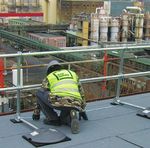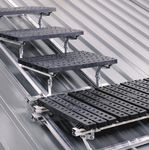What to Protect on Your Rooftop Now - WINTER-READY ROOFTOP FALL PROTECTION - Kee Safety
←
→
Page content transcription
If your browser does not render page correctly, please read the page content below
S E P A R A T I N G P E O P L E F R O M H A Z A R D S
What to Protect on Your Rooftop Now
WINTER-READY ROOFTOP FALL PROTECTION
OCTOBER 2020THE ROOF
Rooftop Fall Protection for Every Season
Separating People from Hazards
The rhythm of the changing seasons is a constant cycle. Predictably, winter will arrive and
even as facility managers and safety professionals plan well in advance for the oncoming weather,
maintenance will be required on their frosty rooftops. An emergency roof repair, a sudden skylight
leak or simply general maintenance on rooftop equipment, there will be times in winter when an
employee must access the roof.
Working on a snow-covered roof poses significant challenges, including exposure to the elements
and the danger of falling. Now is the time to ensure that your company has proper fall protection
in place to minimize the risks of working on wintry roofs and to separate workers from hazards.
Identifying the risks on your roof and their potential liability is the first step.
What to Protect on Your Rooftop Now 1What’s on Top:
The Top 4 Hazards on the Industrial Roof
Keeping Workers Safe is the Priority of Every Building Owner and Safety Manager
Access Points
Understanding how your workers access the roof is the single most important consideration. Access points
are the most frequented hazard on any rooftop. Workers are exposed to this risk twice - every time they
enter and exit the roof to perform tasks. If a worker is required to work on the roof 8 times per year, they are
exposed to the fall hazard 16 times – in each ingress on and every egress off the roof.
OSHA requires that all ladders and hatches be secured with a self-closing gate and safety-compliant railing
to reduce the risk of fall when performing maintenance work. If your rooftop currently uses a chain across
the access point, recent changes in OSHA code has determined that chains are no longer a viable safety
measure for ladder ways or hatches. The Kee Hatch and Kee Gate systems are engineered with Kee Klamp
galvanized steel component railing to separate workers from the danger of falls at access points.
The Rooftop Safety Audit: Kee Safety Fall Protection Experts perform
a critical analysis of the entire rooftop surface to identify the hazards
where workers are exposed to the greatest risk.
What to Protect on Your Rooftop Now 2Rooftop Openings
One of the most popular rooftop features - and the one that is the most dangerous for rooftop
workers - are skylights. OSHA considers skylights to be a hole in the roof and has enacted specific
laws to protect workers from the hazard of falling through these openings. Falling through a skylight
will expose a person to lacerations and further injury as well as create a risk for anyone who may be
inside and below the opening.
Before the winter weather arrives, mark all skylights with a prominent flag or marker so that workers
will be able to distinguish and avoid skylights when they are covered with snow. This is also a good time
to mark roof drains, vents, and the safest routes across your roof to eliminate guesswork when servicing
equipment in the wintertime.
Installing skylight screens will protect workers from falling through the glazed areas when traversing
the snow-covered roof. For metal roofs such as standing seam or corrugated/rib style, the unique
construction and mounting design of Kee Skylight Screens allow the screen to be attached by clamping
to the standing seam without penetration of the roof or the skylight.
Non-penetrating Curb Style Kee Skylight Screens attach to the outer frame of the skylight with
engineered clips. This does not compromise the skylight or the roof and eliminates concern for leaks.
Kee Skylight Screens are available in corrosion-resistant galvanized or stainless steel to withstand rain,
snow, ice, and wind.
For larger domed skylights, we recommend Kee Dome, a free-standing fall protection solution for use
around roof lights dome lights and skylights. Constructed of weather-hardy galvanized steel, Kee Dome
stands firmly around the perimeter of the skylight opening and does not block sunlight. The system is
fully modular, so it can be easily dismantled, moved, and re-erected as required.
What to Protect on Your Rooftop Now 3Unprotected Roof Edges Get in the Zone
1
The edge of the roof is the most visible hazard,
and typically the hazard most people want to Zone 1:
protect first. Protecting workers from slips, trips, When work is performed less than 6
and falls from the roof edge is critical in every feet from the roof edge, employees must
season, and most important in the winter months be protected from falling by a guardrail
when cold temperatures and wind make for icy system, a travel restraint system, or
conditions under foot. personal fall arrest system.
Frequently, a worker’s purpose for accessing the
roof is to service a piece of equipment. Proximity
to the roof edge is a significant factor in identifying
the likelihood of an accident occurring. Remember
2 Zone 2:
Working 6 to 15 feet from the roof edge,
employees must be protected with the
same systems mentioned above; however,
that employees will be working under extreme weather a designated area may be implemented
conditions and it is important to document where when rooftop work is both infrequent and
machinery, HVAC systems, ductwork or drains are temporary.
3
located and if they are too close to an unprotected edge.
Zone 3:
OSHA regulations cite that for any building where work Working 15 feet or more from the roof
is performed within 15 feet of an open roof edge, each edge has the same criteria as above;
worker must be protected from falling by a guardrail however, implementation, training, and
system or other approved safety system. Kee Safety enforcement of a work rule that prohibits
recognizes OSHA’s three work zones and provide access within 15 feet of the roof edge
protective guardrail options for each area of the roof. without using fall protection is acceptable.
This applies only if the work is both
temporary and infrequent.
OSHA’s Definition of
Infrequent and Temporary:
Infrequent means that the work is
performed occasionally. Infrequent work
is usually performed once a year, once
a month, or as needed. Daily, regular, or
routine tasks are not infrequent.
Temporary means that the work is brief or
short. Temporary tasks usually take less
than two hours to complete and are not
complicated.
What to Protect on Your Rooftop Now 4Unprotected Roof Edges
On a flat roof, a protected perimeter limits access to the dangerous edge. Installing a modular,
free-standing railing system that does not penetrate the roof membrane provides an OSHA compliant
barrier. KeeGuard® component guardrail offers multiple configurations for every roof and versatility
on uniquely shaped roofs. The cantilevered bases, made from 100% recycled PVC, provide unrivaled
strength and protection.
For optimal stability on metal profile or standing seam metal roof up to 45 degrees, KeeGuard® Topfix
is attached to the cladding panel via a special base plate engineered specifically for metal roofs. It also
provides non-penetrating safety at the highest level.
KeeGuard® Contractor is versatile and easy to assemble, providing an innovative approach as a portable
or temporary railing system. Suitable for roofs of up to 10-degree pitch, the guardrail components are
galvanized for extreme durability and base weights constructed from recycled PVC for long life.
When it comes to maintenance work on the roof in the winter, do not take risks. Kee Safety offers free
Rooftop Safety Audits, both on-site or virtual assessments, so you can protect your rooftop now before
the temperature drops and the wintry weather arrives. A proactive approach will eliminate the increased
danger of slips and falls due to wet, windy, and icy conditions on unprotected rooftops.
KeeGuard® Non-Penetrating Guardrail
KeeGuard® Topfix KeeGuard® Contractor
What to Protect on Your Rooftop Now 5OSHA COMPLIANC
Be Compliant: OSHA Codes for Industrial Rooftops
Discussions on roof safety can be overwhelming regarding OSHA regulations, inspections, and
regional standards. Kee Safety can assist you with a full understanding of the OSHA codes that
are applicable to your specific rooftop safety concerns.
1 3
Access Points: 1910.28(b)(3)(iv) Unprotected Edges: 1910.28(b)(13)
Each employee is protected from falling into When work is performed less than 6 feet (1.6 m)
a ladder way, floor hole, or ladder way platform from the roof edge, the employer must ensure
hole by a guardrail system and toe boards each employee is protected from falling by a
erected on all exposed sides, except at the guardrail system, safety net system, travel
entrance to the hole, where a self-closing gate restraint system, or personal fall arrest system.
or an offset must be used*
When work is performed at least 6 feet (1.6 m) but
*Chains are no longer permitted for use as a fall less than 15 feet (4.6 m) from the roof edge, the
2
protection system on rooftop access points. employer must ensure each employee is protected
from falling by using a guardrail system, safety net
Rooftop Openings: 1910.28(b)(3)(i) system, travel restraint system, or personal fall
Each employee is protected from falling through arrest system. The employer may use a designated
any hole (including skylights) that is 4 feet (1.2 m) area when performing work that is both infrequent
or more above a lower level by one or more of and temporary.
the following:
• Covers When work is performed 15 feet (4.6 m) or more
• Guardrail Systems from the roof edge, the employer must: protect each
employee from falling by a guardrail system, safety
• Travel Restraint Systems
net system, travel restraint system, or personal fall
• Personal Fall Arrest System arrest system or a designated area.
The employer is not required to provide any fall
protection, provided the work is both infrequent
and temporary; and implement and enforce a work
rule prohibiting employees from going within
15 feet (4.6 m) of the roof edge without using fall
protection in accordance with paragraphs (b)(13)(i)
and (ii) of this section.
What to Protect on Your Rooftop Now 7Contact one of our qualified Fall Protection Experts and schedule a rooftop safety assessment today!
USA Canada
Kee Safety, Inc. Kee Safety, Ltd.
100 Stradtman Street 40 North Rivermede Road, Units 6 - 7
Buffalo, NY 14206 Concord, Ontario L4K 2H3
Tel: (716) 896 4949 Tel: (905) 669 1494
Toll Free: (800) 851 5181 Toll Free: (877) 505 5003
www.keesafety.com www.keesafety.ca
What to Protect on Your Rooftop Now 9You can also read



























































